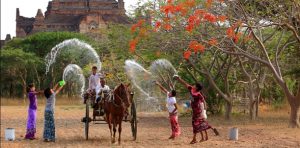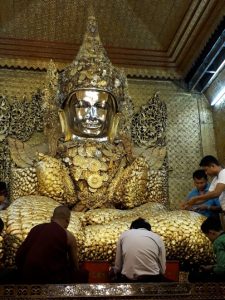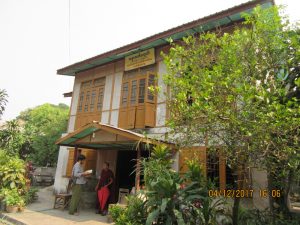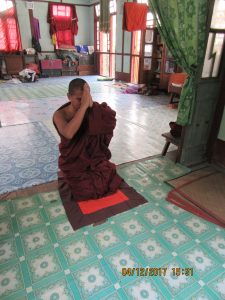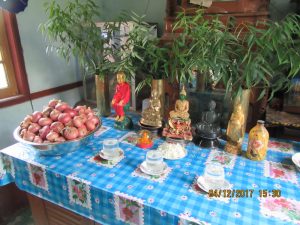Shwebo and his Monastery
A Columban visits his monk friend in Mandalay
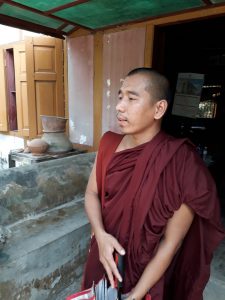 Columban missionary, Fr Kurt Zion, pays a visit to his friend, Nandasara Ashin (Shwebo), a young Buddhist monk involved with inter religious dialogue in the city of Mandalay. St Mary’s Catholic Cathedral annually hosts a lunch for all faiths.
Columban missionary, Fr Kurt Zion, pays a visit to his friend, Nandasara Ashin (Shwebo), a young Buddhist monk involved with inter religious dialogue in the city of Mandalay. St Mary’s Catholic Cathedral annually hosts a lunch for all faiths.
Mandalay used to be the capital of Myanmar formerly Burma. Historically, the last King resided in a fortified palace surrounded by a wide moat. To get to Mandalay one can take the bus (about 8-hour ride) from Yangon or by plane. Luckily, we were able to get rooms with the local diocese for the duration of our stay and the Columban Sisters were our most gracious hosts. Days before the trip, I contacted Shwebo, a Buddhist monk who gave us an introduction on Buddhism together with his friend, Kesera, another monk and Sr Kathleen, a Columban Sister. Kesera could not join us on this trip because he already went back to his home village.
Thingyan Water Festival celebrates the Burmese New Year quite similar to the Thai Songkran Festival. In the Burmese calendar, the new year 1379 begins 17 April this year. My teacher explained that the festival is ushered in with the blooming of beautiful yellow paduak flowers when the first rain comes. But so far no rain has dropped and the heat is as high as 40 degrees on some days. These flowers bloom for only a day. And sadly in 2008, Cyclone Nargis raged through most of Myanmar and fell down most of the paduak trees. Today, people buy plastic imitations of the flower to decorate their houses, cars and everything to remind them of these beautiful flowers.
One of these pagodas features offering and placing thin gold leaves which were pounded by hand on the image of the Buddha. It is considered making merit for one’s self. But a large sign at the entrance before one can climb says that ladies are not allowed. In another place we found some images in a museum with most of the parts smoothened by the constant touching of people who believe that if one touches a certain part of the image, that part of their body will heal if it is sick or painful. In one pagoda, an image of Gautama Buddha with only skin and bones is displayed but clearly this part of the pagoda is seldom visited. Suffering is not something embraced but is something Buddhists try to free themselves from or from the causes of suffering.
Before heading to his monastery, Shwebo brought us to one monastery with a very popular seya do, head monk, the Wasu Monastery. At this time of the year, around 300 men and boys joined the monastery. At this monastery you can learn about Buddhism and also English. We even met Westerners helping them out start their language school. When we came in there were young monks taking a bath preparing for lunch. He told us we can observe the monks eat later. We listened to the head monk preaching in Burmese while Shwebo translates for us. We were then invited to have lunch after all the monks were all served. A good number of the monks were only staying for at least 10 days so they are what they say temporary monks. During Thingyan time many people young and old, men and women come to the monasteries to meditate and live as temporary monks to prepare for the new year or to pay homage to Buddha.
I later asked him about paying homage to Buddha and so he demonstrated to us how they pray. He lays down this brown cloth on the floor before the image of Buddha, kneels down and bows three times. Monks carry around with them a piece of cloth, what we could call ‘prayer mat’ around. It is quite similar to the Muslim prayer rugs that they lay down and use when Muslims pray. I wonder if Christians have such prayer mats?
According to one historian, “…the characteristic prostration of Muslim prayer was then normal in the Christian Middle East, where it still survives in some traditional Christian communities. Prayer mats, still one of the most familiar features of the mosque today, were extensively used by the Christian monks as far apart as Syria and Northumbria before the coming of Islam.”
Dialogue begins in the most practical things just like prayer mats. When I lived in the Fiji Islands, most churches, even the large ones in both indigenous Fijian and Indo-Fijian communities, people sit and pray on the floor. They spread large mats during the celebration of the Eucharist. And so I am used to praying while sitting or kneeling on the floor on prayer mats.
Then maybe we can begin to dialogue by praying together on our prayer mats!

